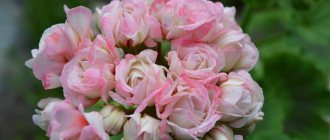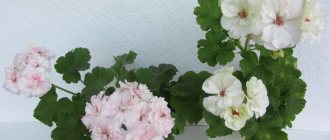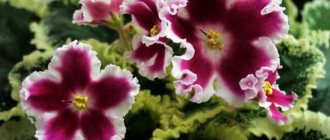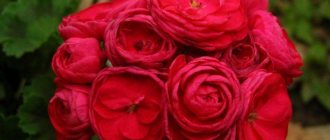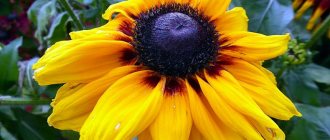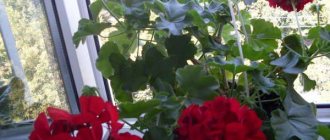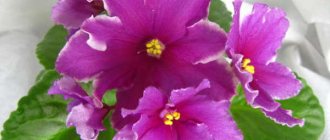Viva Rosita: a brief description of pelargonium
The PAK Viva Rosita variety, bred by a Swedish nursery in 2011, immediately attracts attention with its luxurious flowers.
The shape and layering of the petals is as close as possible to Old English roses. The color of the buds is bright crimson and in contrast with the green foliage this color looks very impressive.
Viva Rosita is very generous with its inflorescences, forming from 20 to 30 buds, which bloom gradually. Young bushes often dry out some of the flowers, but in adulthood the problem disappears when the plant gains strength.
The budding period lasts about 2 weeks, pelargonium forms thick and strong peduncles. Since the flowers are not close to each other, they are easy to see individually.
Viva Rosita forms a compact and lush crown independently, without outside intervention.
Often, one pinching is enough for the crown to begin to branch; in some cases, you can do without manipulating the shoots.
With sufficient lighting, a dark semi-ring is formed on the leaves - a “zone”, which makes pelargonium even more decorative.
PAC Viva Rosita is an easy and trouble-free variety to propagate; to obtain new bushes, it is enough to remove the required number of shoots from the mother plant and root them in a light and loose substrate.
Pelargonium reacts positively to annual transplants; it is better to use a pot a couple of centimeters larger than the previous one.
During the budding period, Viva Rosita geranium needs regular feeding and abundant watering - such care will allow the plant to reach its maximum potential.
At the end of autumn, it is advisable to send pelargonium for the winter, which promotes proper rest and the formation of flower buds for the next season.
Agricultural technology
Pelargoniums are unpretentious plants; caring for them in the garden will not be difficult even for novice flower lovers. The transplant is carried out in early spring, when daylight hours have already noticeably increased. The soil should be well loosened.
It is recommended to plant this flower in a pre-prepared soil mixture of turf, peat, coarse sand, and humus. It is recommended to place chicken or horse manure in it.
For a month, the transplanted plant must be watered every day with settled water. Avoid overwatering, as this will make the plant sick.
The next stage of plant care in the garden is pruning. The first correction of the shape should be carried out approximately a month after the transplant, when the pelargonium has taken root. Only weak, diseased and unproductive shoots are removed. The stem should be left approximately 15 cm long.
It is very important to feed pelargonium growing in the garden correctly and in a timely manner. For this, complex fertilizers are used. During the formation of buds and the beginning of flowering, it is necessary to additionally apply potassium and phosphorus fertilizers. Of the complex fertilizers, Agricola and Kemira are best suited.
Important! Pelargonium Viva Rosita should be watered only with water at room temperature. She doesn't like cold water. It is necessary that during watering a small amount of water gets on the leaves.
Home care
It is best to grow the plant at home on well-lit windowsills. In summer, the plant can be taken out to the balcony or porch.
Note! In conditions of insufficient lighting, the plant stretches and its decorative properties are lost.
The flower does not like heat or cold. The optimal temperature in summer is 20 degrees. In winter, the temperature should be reduced to 16 degrees. The air humidity in the room should be about 55%. The plant tolerates dry air much better and does not even need additional spraying. With increased air humidity, the stems are affected and the plant begins to rot. The plant should not be grown in a room with poor ventilation, because heavy air contributes to the development of diseases.
Pelargonium needs to be watered when the top layer of soil dries out. There should be no stagnation of moisture in the soil, because this negatively affects the condition of the root system and can lead to its rotting.
At home, organic fertilizers are never applied. In winter, no fertilizing is necessary. Nitrogenous fertilizers are the best for it.
From the beginning of spring to mid-autumn, you need to remove the top shoots. This way it is possible to achieve lateral growth of the plant and more luxuriant flowering.
Pelargonium Pac Viva Rosita
Winter care
In autumn and winter, the plant must be put into a dormant state. To do this, the temperature is reduced to 14-16 degrees, watering is reduced to a minimum. To prevent pelargonium from growing, it does not need to be fed.
You must dig up the plant very carefully and always with a lump of earth. Then it is just as carefully transferred to a flower pot.
Reproduction
Pelargoniums are propagated by seeds, dividing the bush and cuttings. Plants grown from seeds grow more abundantly. They need to be planted in early spring. The optimal germination temperature is 20 degrees. Seedlings need to be picked and grown for about 2 months in good light conditions.
Cuttings are carried out in February-March or July-August. A cutting with 3 leaves and about 5-7 cm long is withered and planted in the substrate. The planted cuttings are watered (only to the edge of the pot in which it grows). The cutting can be placed in water and only after the root has grown, planted in the ground.
Propagation of pelargonium by cuttings
Growing rules
PAK Viva Rosita needs conditions typical for zonal pelargoniums, that is, good lighting and warm content, a nutritious, but at the same time loose, permeable substrate.
Thus, growing Viva Rosita pelargonium comes down to several points:
- Lighting. It is preferable to have well-lit window sills that are exposed to the sun for several hours a day. On the south side, it is advisable to shade the pots so that the leaves do not suffer from burns; it is better not to grow them on northern windows;
- Watering. It is necessary to moisten the soil constantly, as the top layer of the substrate dries, but always in moderation. The earthen lump should neither dry out nor become waterlogged;
- Trimming. To obtain a compact bush with a harmonious crown, pelargonium must be pruned. Strong shortening of shoots is carried out at the end of February, sanitary pruning is carried out as necessary. Pinching the apical and lateral cuttings is also required;
- Feeding. During the period of bud formation and flowering, PAC Viva Rosita must be fed using fertilizers for Geraniums or compositions for flowering indoor plants.
How to care for April snow at home
In order for April Snow's pelargonium to develop normally and bloom luxuriantly, it must be properly cared for.
Illumination and temperature conditions
Culture needs bright and diffused lighting. In winter, there may be a need for additional lighting.
Almost all varieties of pelargonium require high temperatures. At the same time, +17-18 degrees is enough for the April Snow culture. In winter, the parameters should be +12-15 degrees.
Watering rules and humidity
The plant needs systematic soil moisture. However, it should be moderate. The culture has delicate roots. If there is excess moisture, there is a risk of rotting processes.
Important! In summer, watering should be quite abundant, especially during drought. In winter, the amount of water must be significantly reduced
The need for watering is reduced in the following situations:
- growing in a plastic container;
- state of winter dormancy;
- first week after transplant;
- decrease in temperature parameters, winter period of time;
- high humidity, lack of sufficient lighting;
- insufficient ventilation in the room.
In any case, the bush should be watered at the root. To better moisten the soil, it is recommended to pour water into a tray. Excess moisture is prohibited. This needs to be monitored based on the condition of the soil. If it is dry at a depth of 1 cm, the soil should be watered.
Fertilizing and soil quality
To fertilize pelargonium, it is recommended to use combined formulations. They are sold in all flower shops. Fertilizing should be done exclusively in summer. This should not be done in winter.
Flower container size
The culture does not require a large container. The faster a plant develops, the more space it requires. Therefore, transplantation is carried out into a looser pot.
Pruning and replanting
It is recommended to form the bush systematically. In this case, shoots should be cut and pinched. The plant needs to be pruned at the end of February or at the beginning of March. As they develop, regrown shoots should be shortened.
The plant must be pruned correctly, taking into account the basic rules of the procedure
Before replanting, the soil must be disinfected. This can be done in different ways:
- heat in the oven or in a frying pan;
- to freeze;
- water the soil with a solution of potassium permanganate;
- water the soil with fungicides.
To replant a crop, you need to remove it from the old pot, shake off the soil and move it to a larger container.
Important! When disinfecting, there is a risk of death of not only harmful, but also beneficial bacteria. This is why it is so important to monitor the condition of the crop and periodically feed it.
About the beneficial properties of pelargonium
Homemade varieties of pelargonium are interesting for their varied effects on human bodies. For some, when in close proximity to a flower, the general condition of the body noticeably worsens, while for others, its smell has a relaxing and calming effect.
In addition to decorative properties, pelargonium is also endowed with useful properties: extracts from it are widely used in the perfume industry, as well as to create a variety of medical preparations.
Pelargonium essential oil is added as a flavoring agent in soap making and to create perfumes of very famous brands. The oil is also used to disinfect indoor air. Its aroma does an excellent job of eliminating various microorganisms and purifies oxygen from impurities harmful to the human body.
Pelargonium Pak Viva Rosita
Pelargonium PAC Viva Rosita surprises and fascinates with its beautiful flowers. They resemble buttercups in shape, but have a terry structure and a rich, bright pink color. The variety is rightfully considered a breakthrough in the selection of this type of plant and attracts the attention of both amateur flower growers and more experienced flower collectors.
The pelargonium bush PAC Viva Rosita wins the hearts of flower lovers with its very compact appearance and rich dark green foliage. Against such a contrasting background, its large flowers seem even more beautiful.
Geranium pak viva rosita, a species bred in Sweden in 2011. Made a big splash at one exhibition in Europe. It has similarities with other representatives of the species. Each inflorescence of this type of geranium can have more than 20 flowers with a diameter of about 6 cm.
The flowers are not located tightly to each other, so they are clearly visible. The peduncle is formed quite strong. It develops rather slowly, but the wait for flowering is compensated by a long flowering period, which lasts about 2 weeks.
The formation of the bush occurs independently, without outside intervention. The foliage is rich green and hard to the touch. By placing the shrub in a place with sufficient sunlight, the owner will ultimately receive a plant that will surprise you with the abundance of its foliage and countless honey plants.
PAC Viva Rosita care
The container for planting PAC Viva Rosita geraniums should be large enough, at least 2 liters. Its root system does not tolerate constraint. In pots with a smaller volume, Viva Rosita dries out the buds and noticeably slows down the growth process.
This variety, unlike the prevailing opinion that pelargoniums love open sun, does not tolerate constant heat and excessive heating of the soil coma. Ideal for it would be a window sill facing east or southwest. But even here it will be necessary to take care of organizing shading from direct rays.
With the arrival of the warm season, it is better to move geraniums (if possible) to the open air. In the shade of deciduous trees on a personal plot, it will bloom and develop much better.
Regarding the temperature regime in apartment conditions, in summer you need to make sure that the temperature does not exceed 30C, and in winter, in order to ensure abundant flowering, it should be relatively low and not exceed 14C.
How to properly care?
- Watering mode.
It is not necessary to moisten the soil for pelargonium with particular frequency. It is enough just to ensure that the root system does not dry out. Don’t forget about the drainage layer, which will protect the plant from stagnant water; you can also make holes in the bottom of the pot so that excess water drains out even faster. The best way to water is through a tray. This way the rhizomes will receive the required amount of moisture. Experienced gardeners advise completely avoiding watering from above, as well as spraying the leaf plates themselves. - Temperature. The most optimal temperature for Viva pelargonium is 20-25 degrees above zero. It will be great if you can take the plant out into the fresh air during warm weather. It is necessary to monitor the condition of the plant in winter, especially if it is located near a window. It is better to remove it from the windowsill, since being close to cold glass can freeze the entire surface of the flower.
- Air humidity. If you want to grow a healthy and abundantly flowering plant, then make sure that the air humidity is at an average level - it should be approximately 60-65%. Do not forget about constant ventilation of the room, which protects the flower from the development of diseases and pests. There is no need to spray Viva pelargonium. This should be done only during hours of very scorching sun and if the air in the room is very dry.
- Loosening the substrate. This procedure is simply necessary for the normal cultivation of Viva pelargonium. Such manipulations help the soil become more breathable, and excess water in such soil will drain away much more easily.
- Feeding. The plant needs to be fertilized during the active growing season - from early spring to mid-autumn. It is best to purchase ready-made complexes in specialized stores. Make sure that the fertilizer contains nitrogen, potassium and phosphorus in equal quantities. Otherwise, either flowering or growth of green mass will predominate. The fertilizing regime is twice a month. In winter, the plant is not fertilized at all.
- Winter care. This is not to say that it is very different from usual. However, there are some nuances here. The flowerpot with the flower needs to be moved to a darker place, the temperature reduced to +15 degrees. At this temperature and moderate watering, the plant may not enter the wintering period. Moisten the soil much less often - once every two weeks will be enough.
This is interesting: Pelargonium Pink Rambler - covering the issue
Pruning and replanting
Viva Rosita growing indoors is pruned every year, leaving shoots with a maximum of 4 nodes untouched. This gives owners the opportunity to have a rather lush and beautifully flowering bush on their windowsill. If yellowed or dried leaves are found on the bush, they are carefully cut off. They perform the action exclusively with a well-sharpened knife.
To prevent the formation of rot at the cut site, it is sprinkled with crushed charcoal. Undesirable leaves are cut off in such a way that the base of the petiole remains unaffected.
Viva Rosita needs to be replanted: young plants annually, and adults only when the root system completely fills the planting container.
At each transplant, drainage is placed at the very bottom of the pot, and then filled to the top with the following mixture: peat, turf, sand, humus and leaf soil. All listed ingredients must be in equal parts.
Find out all the secrets of growing indoor geraniums, watch this interesting video:
Pelargonium PAK Viva - what kind of flower is this, what family does it belong to?
The culture belongs to the Geraniaceae family and has a number of features. In appearance it resembles a terry Asian buttercup. The culture is often compared to red roses.
Pelargonium has beautiful and lush flowering
Brief description, history of origin or selection
Pelargonium Pac Viva Rosita was obtained in Sweden in 2011. The plant was presented at a European exhibition and created a sensation.
The culture is not similar to the rest of the family. The inflorescences are loosely adjacent to each other, the bush is small in size. Pelargonium Pak Viva Rosita is characterized by slow growth. The disadvantage is covered by a long flowering period of 2 weeks. Blooms in summer.
Important! The culture has compact bushes with many branches. The tips of the foliage are dark in color. Each flower reaches 6 cm in diameter.
General information
This plant was first bred by breeders from Sweden, who soon after brought their brainchild to a European exhibition. There, pelargonium caused a great stir, which led to a flurry of positive reviews. This exquisite flower has become a multiple winner at various flower festivals, including in the capital of Russia, where it was brought in 2012.
This variety of pelargonium differs from others in its numerous voluminous flowers, collected in separate umbrellas on a stalk.
The inflorescences of the PAC Viva variety have similar external features to rose buds and a flower such as ranunculus (a special type of buttercup). The surface of the petals resembles terry to the touch. The number of flowers on one umbrella can vary from 6 to 30 pieces. The size of an individual flower is about 5 centimeters. The arrangement of the buds in the inflorescence is quite free, which makes it easy to view each flower in the umbrella.
One of the advantages of PAC Viva pelargonium is its long flowering.
The growth of the inflorescence itself can occur over quite a long time. However, when the buds bloom, they will be able to delight you with their luxurious blooms for two weeks, and sometimes a little longer.
The plant itself is small, it is not a hanging plant, so it will not spread its branches to the sides. They grow quite close to each other. The leaves are hard in texture and rough to the touch. Their color is dark shades of green. Observing a plant that is in a well-lit room, it will become noticeable that its foliage is replenished with even more new leaves. Consequently, an increase in the number of leaves will be followed by an increase in the number of inflorescences. The flower will become even richer and more beautiful to look at.
Varieties of indoor plants with names and what they look like
There are many varieties of culture known. Each variety has a unique botanical description.
Caroline
Characterized by delicate, densely double flowers of lilac-white color. The bushes are decorated with dark green leaves. 3-5 buds appear on each peduncle. The plant has long and lush flowering.
Madeleine
The plants are decorated with wide but small leaves of a dark green hue. The flower belongs to the double zonal species of pelargonium. The inflorescences are white with a pink tint, which appears in the sun.
Rosita
The plant is characterized by bright pink terry buds. Has green leaves. 5-6 buds appear on each peduncle. During the flowering period, which lasts 2 weeks, the bushes are decorated with bright and lush flowers.
The Rosita variety has bright pink inflorescences
Varieties
Breeders at one time were not too lazy to create several types of such a beautiful flower as pelargonium PAC Viva, and, undoubtedly, they only benefited from this. Each of these types has its own individual characteristics, a detailed description of which is given below.
PAC Viva Carolina. A flower of this species pleases us with large buds, the color of which is a combination of white and pale lilac. Densely growing inflorescences have a fleecy surface. There are about 5-6 flowers on one umbrella. An adult healthy representative of this species is distinguished by rich flowering. The leaves have a color typical of PAC Viva pelargonium - rich green.
PAC Viva Madeleine. This pelargonium is the most compact of all PAC Viva varieties. Its leaves are not as large as, for example, “Carolina”, and the color is dark green. The outlines of the bush have a neat shape. PAC Viva Madeleine blooms in much the same way as other representatives of the variety. The flowers are white, with a slight pinkish tint.
PAC Viva Rosita. From the name of the species you can understand what color the petals of pelargonium are - bright pink or coral. The leaves of "Rosita" have a lighter shade than all the others. The plant stands out for its splendor and density of flowering. One inflorescence has about 5-7 flowers. When the buds open, pelargonium looks simply amazing.
This flower will be a bright addition to the design of any room.
PAC Viva Maria. A special feature of pelargonium “Maria” is the unusual color of the buds, which combines white and rich pink. The petals, white at the base, become bright pink closer to the middle. The medium-sized leaves have a rich green color. Pelargonium blooms for a period of fifteen days, has a rich color, while maintaining a neat appearance.
How to grow Pac Viva Rosita and care for the flower
In order for Rosita pelargonium to fully develop, it needs proper care.
Illumination and temperature conditions
The plant needs sufficient light. However, it does not tolerate exposure to direct sunlight, hot weather or overheating of the soil. It is best to place a pot with a plant on a southwest or east window. In warm weather, the flower is taken outside.
For normal development of geraniums, the optimal temperature regime is observed. Pelargonium Viva Rosita should be grown at 20-25 ℃.
Watering rules and humidity
It is not recommended to moisten the soil frequently. This should be done as the top layer of soil dries. The pot must have drainage holes. They ensure rapid removal of fluid.
It is best to moisten the soil through a tray in order to provide the root system with sufficient moisture. Experts advise avoiding watering from above and spraying leaves.
When growing crops, it is important to control air humidity. It should be 60-65%. The room must be ventilated regularly. This helps protect the crop from diseases and parasites.
Important! Pelargonium does not need to be sprayed. The procedure is carried out only when the air is extremely dry or exposed to the scorching sun.
Fertilizing and soil quality
The plant is fed during the active growing season (from early spring to mid-autumn). At the same time, they buy ready-made products in flower shops. The composition must contain nitrogen, potassium and phosphorus. Fertilizers are applied twice a month. In winter, the bushes are not fed.
The plant needs to be fed in a timely manner
Flower container size
Initially, the flower is planted in a medium-sized container. Too large a pot interferes with the normal development of the crop. In such a situation, she spends energy on root growth.
Pruning and replanting
To get a compact plant, pelargonium is pruned. The shoots are greatly shortened at the end of February. In this case, sanitary pruning is carried out as necessary. Be sure to pinch the top and side cuttings.
Features of cultivation and care
Caring for zonal pelargonium is very simple. All you need is to choose a good place for planting and determine the correct watering regime.
Care at home is the most comfortable, since it does not require covering the plant for the winter or controlling rodents. However, there are some nuances here too. For example, if placing pelargonium outdoors in spring and early summer is almost guaranteed to provide the plant with the required amount of light, then indoors you will have to find the brightest and most tranquil corner of the house - preferably a south-east window. If such a place is not found, in winter the flower will have to be illuminated artificially - using lamps.
The home conditions in our regions are ideal for growing zonal pelargonium - comfortable temperatures for the plant are considered to be from 12 to 24 °C, which allows the flower not to fade even in winter. The same applies to humidity: low humidity during the heating season is not a cause for concern, because pelargoniums do not need spraying. All they need is regular watering after the soil dries out. In winter, the frequency of soil moistening can be reduced to once every 10 days.
Zonal pelargoniums prefers loose soils. Special soils for this type of plant can be purchased at a flower shop or mixed yourself. To do this you will need leaf soil, peat, charcoal and sand. All ingredients must be mixed in a ratio of 3:1:1:1.
The flower needs to change the soil once a year. When transplanting from pot to pot, the volume of the new vessel should not exceed the previous one by more than 15%. The plant is planted in the ground in mid-spring and removed from there in the fall.
Pelargoniums are characterized by a high growth rate, which is why the timely formation of a bush becomes an important point. If there is no pruning and removal of old shoots, the plant will stop blooming. Therefore, regularly remove old shoots, and also pinch the flower at growth points no higher than above the sixth leaf.
Pelargonium zonalis, like other house plants, is often affected by pests and fungal diseases. In addition, the cause of disease can be improper care of the flower or its complete absence. To avoid problems, do not disturb the regime of watering, replanting and fertilizing, and also regularly check the plant for the presence of parasites (aphids, whiteflies, spider mites).
Get to know the PAK Viva Rosita variety in the photo:
Features of plant flowering
Pelargonium Rosita does not bloom constantly. The period of rest is replaced by active development.
Period of activity and rest
The dormant state lasts from late autumn to early spring. During this period, the bush should be moved to a darker place and left at a temperature of +15 ℃. With the arrival of spring, all processes in the plant become more active. The flower is again moved to a place with diffused lighting. The formation of buds lasts 2 weeks.
Types and shape of flowers
Pelargonium flowers are dotted with petals. An inflorescence may include several flowers. Characterized by strong buds and dense peduncles.
The process of propagating geraniums by cuttings, when is it best to do it
It is recommended to propagate the plant in February-March or July-August. To take cuttings from a crop, do the following:
- Cut a branch measuring 7 cm from an adult plant. It should have at least 3 leaves.
- The cuttings are dried and placed in a pot with prepared substrate.
- Water along the edge of the pot.
- After 2 weeks the plant will take root.
Important! If desired, move the flower into a container of water. After some time, roots appear.
The culture is propagated by cuttings
Growing problems, diseases and pests
The development of pathologies is a consequence of improper care. Most often, the plant suffers from diseases:
- Fungus Puccinia. The plant is covered with red pigment spots. Subsequently, the bush may dry out.
- Blackleg. In this case, the base of the shoot darkens. The cause of the disease is fungi.
- Gray rot. With this disease, the bushes become covered with a characteristic coating. The problems are caused by cool air and dampness.
- Nematode. The disease affects the roots, which leads to the death of the bush.
- Swelling of leaves. At the same time, they become covered with small growths.
Of the parasites, pelargonium most often suffers from aphids, whiteflies, caterpillars, and termites.
As diseases develop, the leaves become spotted
